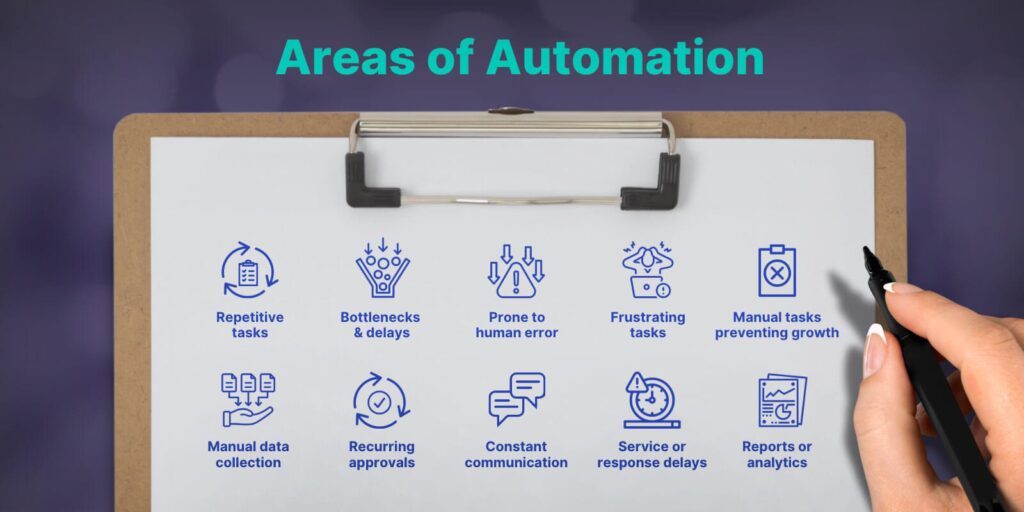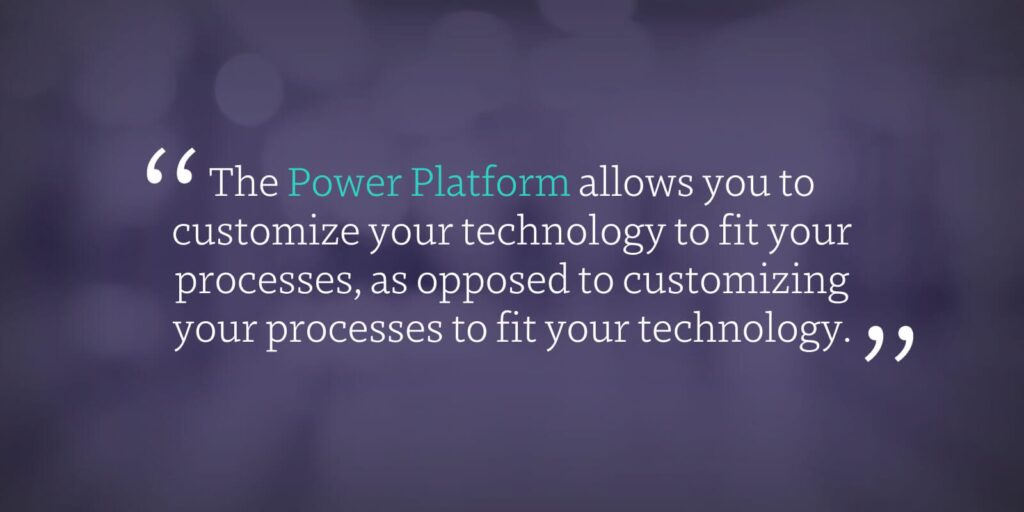Home / Blog / Insights / The Road to Business Process Optimization: Identifying Areas to Automate

•
The Road to Business Process Optimization: Identifying Areas to Automate
Think of your business as it exists today, and ask yourself this question: Would it be possible for us to run a successful operation without the help of technology? Now zoom 10 or 20 years into the future, and ask yourself the same question. If it feels like the likelihood of staying competitive without adapting to new technologies and automating business processes is dwindling—and fast—you’d be correct.
With automation adoption accelerating across industries, the global market size for workflow automation is projected to grow from $19.76 billion in 2023 to over $45 billion by 2032. Nearly 90% of IT professionals report seeing an increase in business growth thanks to efficiencies brought about by automation, and these shifts don’t just impact IT—they impact the entire organization.
That’s because automation doesn’t just save time—it opens the door to new possibilities. By streamlining repetitive, manual tasks, businesses can reallocate resources to focus on innovation, customer satisfaction, and strategic growth. Yet, despite its potential, many businesses struggle with the same question: where do we begin?
This guide is here to help. We’ll explore how to identify areas in your business ripe for automation and process optimization, diving into:
- The need for process optimization
- Identifying areas in your business to automate
- Real-world examples of business process automation
- Achieving automation with Microsoft’s Power Platform
- How to get started with process optimization
The Need for Process Optimization
At the heart of every successful business lies well-structured processes. But as businesses grow, those processes often become cluttered with inefficiencies—manual workarounds, repetitive tasks, and bottlenecks that eat away at productivity. This is where process optimization comes in—the practice of evaluating, refining, and reimagining workflows to ensure they deliver maximum efficiency and value.
Inefficient processes can have a significant cost. A study by IDC estimates that companies lose 20-30% of their annual revenue due to inefficiencies, much of which stems from outdated workflows and manual tasks. Beyond the monetary loss, these inefficiencies can lead to employee burnout, poor customer experiences, and missed opportunities for growth.
Automation addresses these challenges in a powerful way. By introducing technology to handle repetitive, time-consuming tasks, you can:
1) Reduce Human Error
Automating workflows can reduce errors in your work by 70%, helping your business avoid costly mistakes by maintaining more accuracy in operations.
2) Free Up Time
Employees save valuable hours with automation tools, with about 30% of IT professionals reporting time savings for their teams. Additionally, over 90% say process automation enables employees to focus on more complex, strategic tasks that strengthen productivity.
3) Improve Customer Service
On average, organizations experience a 7% boost in customer engagement and satisfaction when automation is integrated into service workflows, such as chatbots and rapid ticket resolution.
4) Increase Morale
Over 50% of employees attribute poor work-life balance to workflow inefficiencies. By automating repetitive tasks, teams can focus on meaningful work, leading to greater job satisfaction and reduced burnout.
5) Cut Costs
Because each business is unique, it’s difficult to quantify just how much you’ll save by automating your business processes. But what’s clear is that automation consistently reduces the time and resources spent on repetitive tasks, eliminates costly errors, and improves overall efficiency, making it a worthwhile investment for long-term savings and growth.
These benefits of process optimization ripple throughout your organization—silently driving growth and competitive advantage from behind the scenes.
Identifying Areas to Automate Business Processes
Not all processes are created equal when it comes to automation. The key to success lies in identifying the areas to automate business processes that will have the greatest impact. These are often tasks that are repetitive, time-consuming, or prone to errors.
Here’s where to look first:
1) Data Entry
Any process involving manual data input, such as updating spreadsheets or transferring information between systems, is a prime candidate. Take accounts payable, for example, where 73% of teams say they struggle to match invoices and purchase orders—something so simple, yet so time consuming.
2) Reporting and Analytics
Generating reports can be tedious and repetitive if your data exists in disparate systems or isn’t easy to understand without significant manual intervention.
3) Routine Approvals
Tasks like expense report approvals or leave requests can be streamlined using automated workflows, ensuring faster processing without creating internal bottlenecks.
4) Customer Service
Automating common customer service interactions, such as answering FAQs with chatbots or using automated email responses, can enhance customer satisfaction and free up your staff for more complex issues.
5) Inventory and Supply Chain
Automation can track stock levels, generate reorder alerts, and streamline supplier communications, reducing the risk of errors and delays.
6) IT Operations
From software updates to routine security checks, IT teams can benefit greatly from automating repetitive tasks, ensuring consistency and reliability. For example, 82% of IT executives expect AI to improve DevSecops, the automated workflows that incorporate security practices throughout the development lifecycle, in the next two years.
The opportunities for process optimization and automation don’t end here. By examining each department individually, you’ll begin to spot areas for improvement. Here are some questions you can use to audit your processes across the business.
Questions to Help Identify Automation Opportunities
To pinpoint where automation could help, ask yourself:
- Which tasks are repetitive and take up a lot of time?
- Where are we experiencing delays or bottlenecks in workflows?
- Which processes are prone to human error?
- What tasks do employees find most tedious or frustrating?
- Are there areas where manual tasks are holding back scalability or growth?
- What tasks rely heavily on manual data collection or entry?
- Are there recurring approvals that follow the same predictable rules?
- Which processes depend on constant back-and-forth communication between teams?
- Where do customers experience delays in service or responses?
- Are there reports or analytics that take significant effort to compile manually?
By focusing on these areas, you can begin to build a roadmap for automating processes that offer the biggest return on investment.

Real-World Business Process Automation Examples
Automation has started to transform operations across every industry. Here are a few business process automation examples from organizations who have experienced the impact first-hand.
Cineplex: Streamlining Business Processes
Cineplex, a leading entertainment company, was facing inefficiencies caused by manual, time-consuming tasks across their business. By automating processes like invoice processing, payroll, and financial reporting, Cineplex was able to speed up workflows, reduce errors, and improve overall productivity. This transformation not only saved time but also empowered teams to focus on more strategic priorities.
Epiq: Enhancing Employee Onboarding
Epiq, a global legal services provider, was struggling with an inconsistent and manual onboarding process. To address this, they implemented a streamlined solution that automated tasks like assigning licences and creating email accounts for new employees. This automation significantly reduced onboarding time, saving the company over $500,000 annually and allowing it to quickly scale for short-term projects.
T-Mobile: Optimizing Initiative Approvals
T-Mobile, a major telecommunications company, faced challenges in managing customer initiatives, such as device promotions and service offers. The complex approval process was time-consuming and involved multiple stakeholders. By developing the “Orbit App,” T-Mobile automated the intake and approval workflows, integrating various departments and streamlining communications. This solution saved the company over $4 million and 97,000 hours, allowing for a 150% annual growth in initiatives without adding resources.
The Common Thread—Microsoft’s Power Platform
What’s the common thread in these three powerful, real-world examples of automation? These companies achieved their automation successes with the help of Microsoft’s Power Platform. Whether it was automating workflows, managing data, or enhancing customer experiences, the Power Platform enabled these businesses to address unique challenges and scale their operations effectively. Let’s talk about how your oranization could achieve similar results.
Achieving Automation with Microsoft’s Power Platform
The Microsoft Power Platform offers a suite of intuitive tools to help organizations automate workflows, analyze data, and build custom applications. Designed for businesses of all sizes, it simplifies automation and enables scalable, efficient solutions.
“The Microsoft Power Platform allows you to do low-code rapid development within your environment to automate different processes,” says Richard McLeod, Director of Technology at Convverge. “The Power Platform allows you to customize your technology to fit your processes, as opposed to customizing your processes to fit your technology.”

For businesses of all sizes, this is powerful. It allows you to maintain the workflows unique to you while leveraging automation to drive efficiency and innovation. Rather than being forced to adapt to rigid, off-the-shelf systems, the Power Platform helps you tailor solutions that align directly with your needs.
Here’s how different tools in the Power Platform help you do just that:
- Power Automate: Automates workflows across applications and services, eliminating repetitive tasks like data transfers and approvals. For example, Cineplex used Power Automate to optimize payroll and reporting processes.
- Power Apps: Enables the creation of custom apps without coding expertise. T-Mobile’s “Orbit App,” built with Power Apps, streamlined initiative approvals, saving millions annually.
- Power BI: Transforms raw data into actionable insights with real-time dashboards, helping businesses make informed, data-driven decisions.
- Power Pages: A low-code solution for building secure, data-driven websites to enhance customer and partner interactions.
- Copilot Studio: Empowers teams to integrate AI-driven automation into workflows, helping them achieve faster and smarter decision-making.
With seamless integration into Microsoft 365, Dynamics 365, and Azure, the Power Platform makes it simpler to innovate, optimize business processes, and drive growth.
Getting Started with Process Optimization and Automation
Starting your automation journey might seem overwhelming at first. The key is to begin with small, manageable projects and build from there. Here’s how to get started:
Look for easy wins. Start with the simple stuff—those repetitive, time-consuming tasks that no one enjoys. Things like data entry, creating reports, or handling routine approvals are great candidates.
Get input from your team. The people closest to the work usually have the best ideas about what could be improved. Talk to your team about what feels like a bottleneck or a time drain. Not only will you get valuable insights, but involving them early helps everyone feel part of the change.
Use tools that work for everyone. With tools like Power Automate and Power Apps, you don’t need to be a tech wizard to create custom solutions. These low-code tools let anyone in your organization design workflows and apps that solve real problems.
Test the waters. Try out your automation with a small group or a specific task before rolling it out across the board. Pay attention to what works, what doesn’t, and how it’s helping. Make adjustments as needed—it’s all part of the process.
Consult a partner.The road to automation doesn’t have to be a lonely one. Consult Power Platform professionals, like our team at Convverge, to give you an objective, outside perspective on areas in your business that could benefit from automation and help to build your custom solutions.
Build on your success. Once you’ve seen how much time and energy automation can save, it’s time to think bigger. Expand to more complex processes or roll out automation across other departments.
The great thing about automation is that it grows with you. By starting small and refining as you go, you can create systems that work seamlessly with your business—and free up time to focus on what really matters.
Is Process Automation Calling You?
Getting started with automation can feel daunting—but you don’t have to go it alone. At Convverge, we help businesses like yours tap into the power of automation with a clearly defined process. We take the time to understand the ins and outs of your organization, collaborating closely with business leaders to identify and unfold key areas to streamline.
From automating repetitive tasks to building custom apps within Microsoft’s Power Platform, our team is here to help you work smarter. Subscribe to our insights to stay up-to-date on all things automation, or dive in to learn more about our Power Platform Consulting Services.


